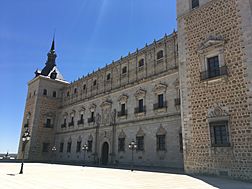Alcázar of Toledo facts for kids
The Alcázar of Toledo (which means 'the castle' in Arabic) is a large stone fortress in Toledo, Spain. It stands on the highest part of the city. This huge building is shaped like a square, about 60 meters (almost 200 feet) on each side. It has four tall towers, also 60 meters high, with pointy tops called "Madrid spires." Most of the Alcázar was rebuilt between 1939 and 1957. This happened after it was heavily damaged during a major event called the siege of the Alcázar in the Spanish Civil War.
Contents
History of the Alcázar
From Roman Palace to Royal Fortress
The Alcázar has a very long history. It was first used as a Roman palace way back in the 3rd century. Later, it was rebuilt and made grander in the 1540s. This work was done for Charles I (who was also Charles V, Holy Roman Emperor) and his son Philip II of Spain.
In 1521, a famous explorer named Hernán Cortés visited the Alcázar. He met with Charles I there after his adventures conquering the Aztecs. The name "Alcázar" comes from the Arabic word al-qaṣr, which means 'the castle'. This word itself came from the Latin word 'castrum'.
The Alcázar During the Spanish Civil War
The Siege of the Alcázar
The Alcázar played a very important role during the Spanish Civil War. This war happened in Spain from 1936 to 1939. During this time, a military leader named Colonel José Moscardó Ituarte defended the building. He held it against a much larger group of soldiers from the Second Spanish Republic. This event is known as the siege of the Alcázar.
A Difficult Choice
The story of Colonel Moscardó and his son, Luis, became very famous. The Republican forces captured Luis, who was 24 years old. They told Colonel Moscardó that if he did not give up the Alcázar, they would kill his son.
Moscardó spoke to his son on the phone to confirm this terrible threat. He then told Luis to "Commend your soul to God, shout 'Viva España!' and die like a hero." Colonel Moscardó bravely refused to surrender the Alcázar.
After the Siege
Reports from that time said that the Republicans then killed Moscardó's son. Other historians say Luis was actually killed about a month later. This was said to be in response to an air raid. The dramatic story also hides what happened to other people. Many male hostages, mostly from the Guardia Civil, were taken into the Alcázar at the start of the siege. Their fate is not fully clear. Some sources say these men were "never heard of again." However, at least one journalist who visited the Alcázar right after it was freed saw some prisoners. They were chained to a railing in a cellar.
A Symbol of Strength
The events at the Alcázar during the Spanish Civil War made it a strong symbol. It became a symbol for Spanish Nationalism. This even led to a far-right newspaper being named El Alcázar. This newspaper started during the civil war. It continued until Spain became a democracy again after Francisco Franco's death. It was the voice for a group called Búnker, who did not want changes.
By the end of the siege, the Alcázar building was very badly damaged. After the war ended, it was completely rebuilt. Today, the Alcázar is home to two important places. It houses the Castilla-La Mancha Regional Library. It also has the Museum of the Army ("Museo del Ejército"). This museum used to be in Madrid.
Images for kids
-
Heinrich Himmler visits the Alcázar with José Moscardó in October 1940.
-
"Interview of Emperor Charles V with Francisco Pizarro in the Alcázar", ca. 1887 by Ángel Lizcano Monedero
-
Tent of Charles V, Army Museum
See also
 In Spanish: Alcázar de Toledo para niños
In Spanish: Alcázar de Toledo para niños











